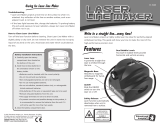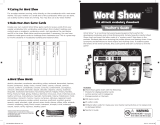Page is loading ...

Learning the difference between left and right can be difficult
for many children. Left and Right Rings make it fun and easy!
Here are some ideas to get you started.
“Hokey Pokey”
Have each child wear both left and right rings. Sing the traditional song with
children following the directions.
You put your right hand in.
You put your right hand out.
You put your right hand in, and you shake it all about.
You do the Hokey Pokey, and you turn yourself around.
That’s what it’s all about.
Continue with your left hand, right foot/left foot, right shoulder/left shoulder,
right elbow/left elbow, and so on.
Variation:
For younger or more inexperienced children, or children who are
really struggling with this concept, have them wear just one ring (either left or
right). Sing the song using only that side of the body.
“Simon Says” Directions
Play this familiar game with a small group of students, or play it outdoors
where you have more room. Have children wear both right and left rings.
Include directions such as the following:
Raise your right hand.
Shake your left hand.
Hop on your right foot.
Stamp your left foot.
Step to the right.
Turn to the left.
As children understand the concept better, you may wish to give more complex
instructions such as, “Touch your left knee with your right hand. Put your left
hand on your right shoulder,” etc.
EI-1008
Ages 4
+
Grades Pre-K
+
Following Directions Treasure Hunt
Hide a small toy or other object somewhere in your classroom. Have a child or
small group of children wear rings. Give children directions such as, “Walk three
steps forward. Stop. Turn right and walk five steps. Stop. Turn left. Walk ten
steps,” etc. until they have reached the location where you have hidden the toy.
Give Me a Hand
Give each student a sheet of construction paper. Then have children place their
hands, palms down, on the paper. Trace around their hands with a crayon or
have children work together to trace one another’s hands. Have students wear
both left and right rings. Instruct children to label their traced hands L and R,
using their rings as a reference. Then work with groups of children to play a
game. Provide markers such as paper clips, plastic counters, buttons, or other
small objects. Have children use the paper with the traced hands as a game
board or work mat. Give children directions such as, “Place a paper clip on
your right hand. Place two buttons on your left hand,” etc.
Opposite Directions
Have children wear both left and right rings. Pair children up and have them
stand opposite one another. Then give directions such as, “Raise your right
hand. Wave your left hand. Use your right hands to shake with one another
and say, ‘Nice to meet you.’” Point out that when you are facing someone
that person’s right and left hands are opposite yours. This is a dicult concept,
and children will benefit from repeated exposure to it.
All-day Learning
Have children wear one or both rings all day long. (If this interferes with
writing, have them take the ring(s) o as necessary.) Throughout the day, make
requests such as, “Raise your left hand if you want to play soccer at recess
today. Raise your right hand if you know the answer to the math problem; raise
your left hand if you don’t,” etc.
Look for AlphaRings (EI-1006) for hands-on alphabet learning!
© 2008 Educational Insights, Inc., Rancho Dominguez, CA 90220 (USA).
All rights reserved. Learning Resources, Ltd., King’s Lynn, Norfolk (UK).
Made in China. Please retain this information.
CUSTOMER SERVICE: (800) 995-4436 Monday – Friday
WEBSITE: www.Educational
Insights.com
L
R

Learning the difference between left and right can be difficult
for many children. Left and Right Rings make it fun and easy!
Here are some ideas to get you started.
“Hokey Pokey”
Have each child wear both left and right rings. Sing the traditional song with
children following the directions.
You put your right hand in.
You put your right hand out.
You put your right hand in, and you shake it all about.
You do the Hokey Pokey, and you turn yourself around.
That’s what it’s all about.
Continue with your left hand, right foot/left foot, right shoulder/left shoulder,
right elbow/left elbow, and so on.
Variation:
For younger or more inexperienced children, or children who are
really struggling with this concept, have them wear just one ring (either left or
right). Sing the song using only that side of the body.
“Simon Says” Directions
Play this familiar game with a small group of students, or play it outdoors
where you have more room. Have children wear both right and left rings.
Include directions such as the following:
Raise your right hand.
Shake your left hand.
Hop on your right foot.
Stamp your left foot.
Step to the right.
Turn to the left.
As children understand the concept better, you may wish to give more complex
instructions such as, “Touch your left knee with your right hand. Put your left
hand on your right shoulder,” etc.
EI-1008
Ages 4
+
Grades Pre-K
+
Following Directions Treasure Hunt
Hide a small toy or other object somewhere in your classroom. Have a child or
small group of children wear rings. Give children directions such as, “Walk three
steps forward. Stop. Turn right and walk five steps. Stop. Turn left. Walk ten
steps,” etc. until they have reached the location where you have hidden the toy.
Give Me a Hand
Give each student a sheet of construction paper. Then have children place their
hands, palms down, on the paper. Trace around their hands with a crayon or
have children work together to trace one another’s hands. Have students wear
both left and right rings. Instruct children to label their traced hands L and R,
using their rings as a reference. Then work with groups of children to play a
game. Provide markers such as paper clips, plastic counters, buttons, or other
small objects. Have children use the paper with the traced hands as a game
board or work mat. Give children directions such as, “Place a paper clip on
your right hand. Place two buttons on your left hand,” etc.
Opposite Directions
Have children wear both left and right rings. Pair children up and have them
stand opposite one another. Then give directions such as, “Raise your right
hand. Wave your left hand. Use your right hands to shake with one another
and say, ‘Nice to meet you.’” Point out that when you are facing someone
that person’s right and left hands are opposite yours. This is a dicult concept,
and children will benefit from repeated exposure to it.
All-day Learning
Have children wear one or both rings all day long. (If this interferes with
writing, have them take the ring(s) o as necessary.) Throughout the day, make
requests such as, “Raise your left hand if you want to play soccer at recess
today. Raise your right hand if you know the answer to the math problem; raise
your left hand if you don’t,” etc.
Look for AlphaRings (EI-1006) for hands-on alphabet learning!
© 2008 Educational Insights, Inc., Rancho Dominguez, CA 90220 (USA).
All rights reserved. Learning Resources, Ltd., King’s Lynn, Norfolk (UK).
Made in China. Please retain this information.
CUSTOMER SERVICE: (800) 995-4436 Monday – Friday
WEBSITE: www.Educational
Insights.com
L
R
/














